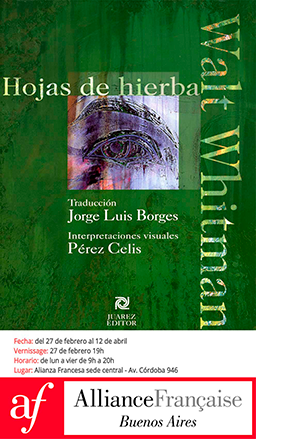LEANDRO FEAL AND HIS GREEN HAVANA
The Green Havana project is a captured sample of a time and an attitude, the same one that transits between evasion and hedonism and the social reality of the Cuban capital, a unique and referential site of that almost isolated Cuba and of a popular culture grown in the shadow of political influences.
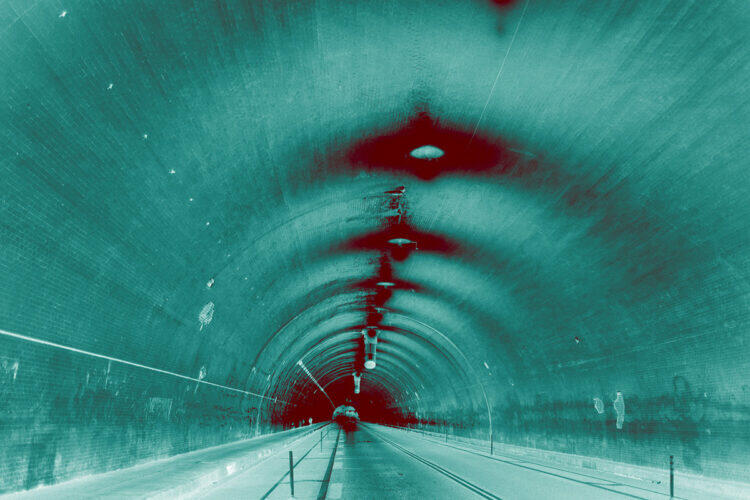
Leandro Feal (Havana, Cuba, 1986) has produced a series of snapshots that capture this essence and that point to the future of a whole generation of young people, including himself, who have grown up in that dynamic, surrealist city with a distorting capacity, and that turns their memories into greenish negatives.
The allusion and the essential part of the exhibition lies in the symbolism behind Caribe (2020-22), the seminal piece behind these series of photographs and which represents a television set of that brand, an idiosyncratic device in Cuban homes and which, with its island manufacture licensed from the Soviet Union, alludes to that temporary tunnel of memories dyed green just as the screens were painted to obtain a failed sensation of reverie. From that action, other memories emerge from that leisure installed in the generational halo, where recurring characters of the intellectual and artistic scene coexist with social realism and brutalism in social service, creating a pressing contrast.
Although Green Havana is the central axis of the exhibition, it is also the perfect excuse to complement the concept of leisure, of the emotional hangover, of the distraction of a youth, factors represented in La fiesta vigilada, a video photo essay that travels through the city's nightlife as a symbol of resistance and raises that first censored PM to the altars of references, the same ones that also constitute the complementary installation that leads to a critique and a certain nostalgia for the ephemeral nature of the festive moment and its construction in the generational identity.
Green Havana, by Leandro Feal, can be seen until August 3, 2024 at Galería El Apartamento, Calle de la Puebla, 4, Madrid, Spain.
Related Topics
May interest you
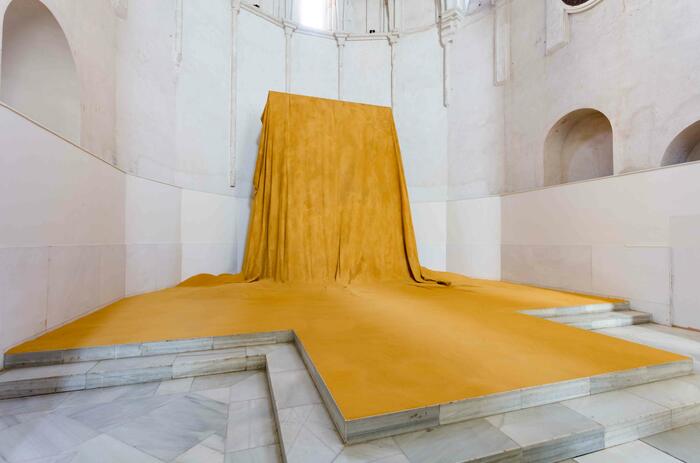
Delcy Morelos (Tierralta, Colombia, 1967) lands at the Centro Andaluz de Arte Contemporáneo (CAAC) in Seville with Profundis, an exhibition that gathers the spectacular intervention she has made ex profeso in the monumental areas of the Sevillian institution and that focuses on revitalizing the ancestral link of man with the earth, as well as capturing, through botany, the symbolism of the relations between Europe and America.
THE GERMINATION OF HISTORY ACCORDING TO DELCY MORELOS, IN SEVILLE
Delcy Morelos (Tierralta, Colombia, 1967) lands at the Centro Andaluz de Arte Contemporáneo (CAAC) in Seville with Profundis, an exhibition that gathers the spectacular intervention she has made ex profeso in the monumental areas of the Sevillian institution and that focuses on revitalizing the ancestral link of man with the earth, as well as capturing, through botany, the symbolism of the relations between Europe and America.

Delcy Morelos (Tierralta, Colombia, 1967) lands at the Centro Andaluz de Arte Contemporáneo (CAAC) in Seville with Profundis, an exhibition that gathers the spectacular intervention she has made ex profeso in the monumental areas of the Sevillian institution and that focuses on revitalizing the ancestral link of man with the earth, as well as capturing, through botany, the symbolism of the relations between Europe and America.
THE GERMINATION OF HISTORY ACCORDING TO DELCY MORELOS, IN SEVILLE
Delcy Morelos (Tierralta, Colombia, 1967) lands at the Centro Andaluz de Arte Contemporáneo (CAAC) in Seville with Profundis, an exhibition that gathers the spectacular intervention she has made ex profeso in the monumental areas of the Sevillian institution and that focuses on revitalizing the ancestral link of man with the earth, as well as capturing, through botany, the symbolism of the relations between Europe and America.
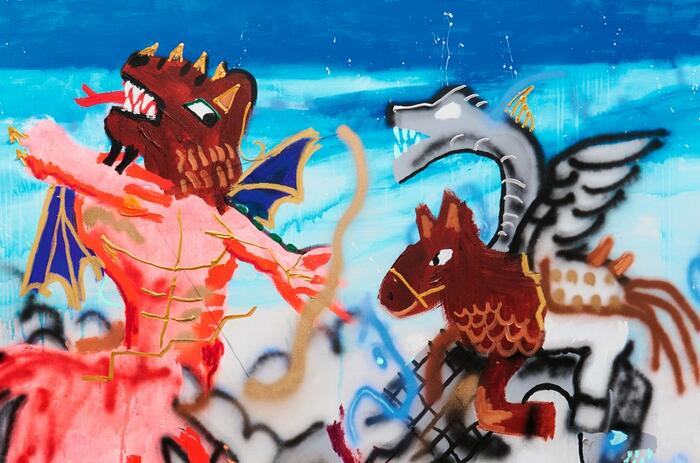
Standing before the expressive forcefulness of Mexican-American Robert Nava (East Chicago, USA, 1985) can be risky. At first glance, the primitivism in the technique used in his canvases is shocking in the conversion of the strength of the stroke and the basics of the gesture into a language that agglutinates a brute force. Perhaps for that reason, the usual tendency of those who face his work is to quickly pigeonhole it out of the academic, out of that refinement that is presupposed -although less and less- to those who fill the room of a museum, to let themselves be carried away by the urgency of expression in front of that pretended good taste.
THE URGENT BESTIARY OF ROBERT NAVA
Standing before the expressive forcefulness of Mexican-American Robert Nava (East Chicago, USA, 1985) can be risky. At first glance, the primitivism in the technique used in his canvases is shocking in the conversion of the strength of the stroke and the basics of the gesture into a language that agglutinates a brute force. Perhaps for that reason, the usual tendency of those who face his work is to quickly pigeonhole it out of the academic, out of that refinement that is presupposed -although less and less- to those who fill the room of a museum, to let themselves be carried away by the urgency of expression in front of that pretended good taste.
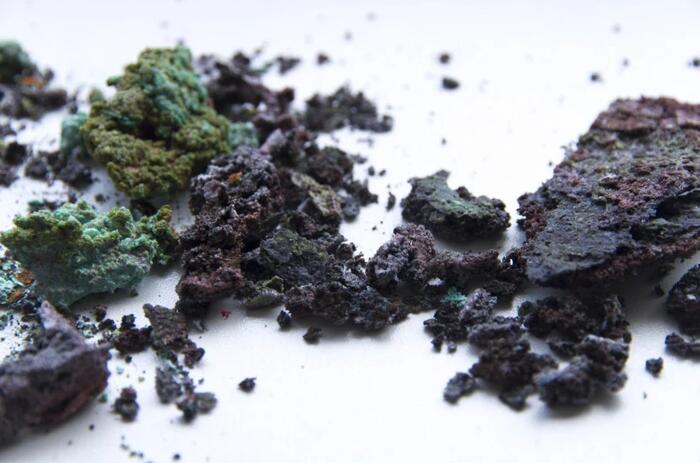
For some time now, the Inéditos program carried out by La Casa Encendida -an institution of the Montemadrid Foundation- has become a more or less reliable thermometer of the emerging curatorial scene that has Spain as its epicenter. As a result of that consolidation, within that faithful reflection, the Spanish social and artistic structure itself plays a very prominent role.
THE IBERO-AMERICAN CURATORSHIP AFTER INÉDITOS 2024
For some time now, the Inéditos program carried out by La Casa Encendida -an institution of the Montemadrid Foundation- has become a more or less reliable thermometer of the emerging curatorial scene that has Spain as its epicenter. As a result of that consolidation, within that faithful reflection, the Spanish social and artistic structure itself plays a very prominent role.
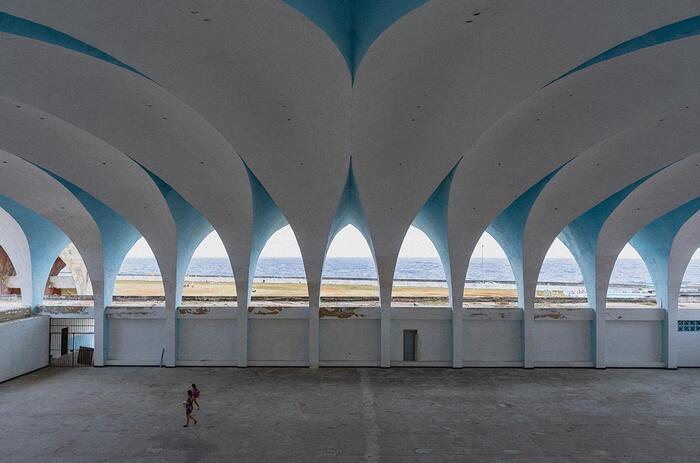
Included within the activities of the program Transcultura. Integrating Cuba, the Caribbean and the European Union through Culture and Creativity, an initiative coordinated by the European Union and implemented by UNESCO in Havana, fifteen young Caribbean photographers between the ages of 18 and 35 will participate in PHotoESPAÑA 2024 with the presentation of their recent work, in addition to being able to interact professionally with cultural agents and the sector.
YOUNG CARIBBEAN PHOTOGRAPHY AT PHOTOESPAÑA
Included within the activities of the program Transcultura. Integrating Cuba, the Caribbean and the European Union through Culture and Creativity, an initiative coordinated by the European Union and implemented by UNESCO in Havana, fifteen young Caribbean photographers between the ages of 18 and 35 will participate in PHotoESPAÑA 2024 with the presentation of their recent work, in addition to being able to interact professionally with cultural agents and the sector.

Patricio Reig (San Juan, Argentina, 1952) exhibits at the Centre Cultural La Mercè in Girona Anatomía de la mirada, a proposal that deals with the dissection of the act of looking and its individual and subjective approach.
PATRICIO REIG AND THE ANATOMY OF THE GAZE
Patricio Reig (San Juan, Argentina, 1952) exhibits at the Centre Cultural La Mercè in Girona Anatomía de la mirada, a proposal that deals with the dissection of the act of looking and its individual and subjective approach.

El Museo del Barrio presented the exhibition Amalia Mesa-Bains: Archaeology of Memory, the first retrospective exhibition by the pioneering artist, curator, and theorist. Born in 1943 to a Mexican immigrant family, Mesa-Bains has been a leading figure in Chicanx art for nearly half a century.
AMALIA MESA-BAINS: ARCHAEOLOGY OF MEMORY
El Museo del Barrio presented the exhibition Amalia Mesa-Bains: Archaeology of Memory, the first retrospective exhibition by the pioneering artist, curator, and theorist. Born in 1943 to a Mexican immigrant family, Mesa-Bains has been a leading figure in Chicanx art for nearly half a century.

It could have been an ordinary retrospective, but the decision to participate in some way in the creative process is a differential and even declarative point in Tembló acá un delirio, the exhibition that Museo CA2M in Móstoles delves into the figure, and at first hand, of Ana Gallardo (Rosario, Argentina, 1958).
ANA GALLARDO'S RECONSTRUCTION AND “DELIRIUM”
It could have been an ordinary retrospective, but the decision to participate in some way in the creative process is a differential and even declarative point in Tembló acá un delirio, the exhibition that Museo CA2M in Móstoles delves into the figure, and at first hand, of Ana Gallardo (Rosario, Argentina, 1958).

Tania Pardo (Madrid, Spain, 1976) is the new Director of the Museo Centro de Arte Dos de Mayo (CA2M Museum), the museum of contemporary art of the Community of Madrid. Pardo's career until her recent appointment has been built on a detailed work of promotion and visibility of emerging art through the curatorial actions she has developed in numerous Spanish institutions.
INTERVIEW WITH TANIA PARDO, NEW DIRECTOR OF CA2M MUSEUM
Tania Pardo (Madrid, Spain, 1976) is the new Director of the Museo Centro de Arte Dos de Mayo (CA2M Museum), the museum of contemporary art of the Community of Madrid. Pardo's career until her recent appointment has been built on a detailed work of promotion and visibility of emerging art through the curatorial actions she has developed in numerous Spanish institutions.
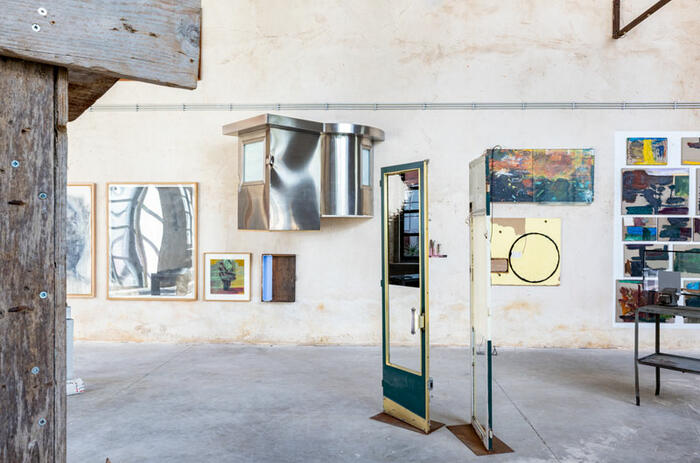
Pedro Cabrita Reis (Lisbon, Portugal, 1956) celebrates his half century of artistic production in ATELIER, a complex and complete exhibition that covers what is, perhaps, one of the most relevant proposals of the last decades that has emerged from the Portuguese plastic arts. More than 1,500 works from his personal collection fill eight pavilions of Mitra, a space donated by the Santa Casa da Misericórdia de Lisboa, located in Marvila, the same town where the artist lives and works.
ATELIER, THE HALF-CENTURY ANTHOLOGY OF CABRITA REIS
Pedro Cabrita Reis (Lisbon, Portugal, 1956) celebrates his half century of artistic production in ATELIER, a complex and complete exhibition that covers what is, perhaps, one of the most relevant proposals of the last decades that has emerged from the Portuguese plastic arts. More than 1,500 works from his personal collection fill eight pavilions of Mitra, a space donated by the Santa Casa da Misericórdia de Lisboa, located in Marvila, the same town where the artist lives and works.
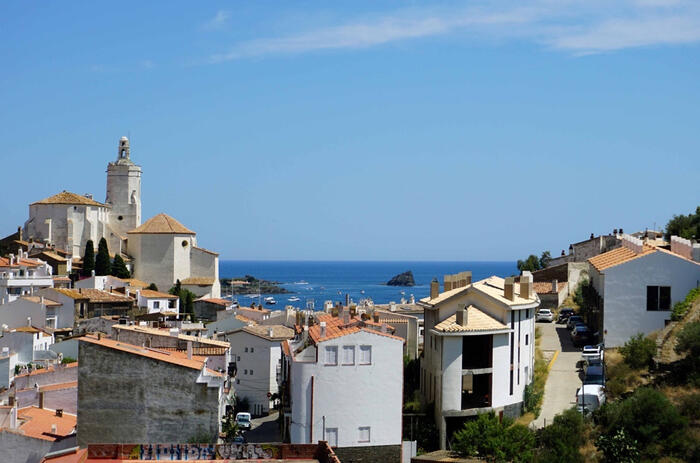
"If you hear a voice within you say, "you cannot paint," then by all means paint, and that voice will be silenced".Vincent Van Gogh
PATRICIA SICARDI, A BOOK, A LIFE
"If you hear a voice within you say, "you cannot paint," then by all means paint, and that voice will be silenced".Vincent Van Gogh

Delcy Morelos (Tierralta, Colombia, 1967) lands at the Centro Andaluz de Arte Contemporáneo (CAAC) in Seville with Profundis, an exhibition that gathers the spectacular intervention she has made ex profeso in the monumental areas of the Sevillian institution and that focuses on revitalizing the ancestral link of man with the earth, as well as capturing, through botany, the symbolism of the relations between Europe and America.
THE GERMINATION OF HISTORY ACCORDING TO DELCY MORELOS, IN SEVILLE
Delcy Morelos (Tierralta, Colombia, 1967) lands at the Centro Andaluz de Arte Contemporáneo (CAAC) in Seville with Profundis, an exhibition that gathers the spectacular intervention she has made ex profeso in the monumental areas of the Sevillian institution and that focuses on revitalizing the ancestral link of man with the earth, as well as capturing, through botany, the symbolism of the relations between Europe and America.

Standing before the expressive forcefulness of Mexican-American Robert Nava (East Chicago, USA, 1985) can be risky. At first glance, the primitivism in the technique used in his canvases is shocking in the conversion of the strength of the stroke and the basics of the gesture into a language that agglutinates a brute force. Perhaps for that reason, the usual tendency of those who face his work is to quickly pigeonhole it out of the academic, out of that refinement that is presupposed -although less and less- to those who fill the room of a museum, to let themselves be carried away by the urgency of expression in front of that pretended good taste.
THE URGENT BESTIARY OF ROBERT NAVA
Standing before the expressive forcefulness of Mexican-American Robert Nava (East Chicago, USA, 1985) can be risky. At first glance, the primitivism in the technique used in his canvases is shocking in the conversion of the strength of the stroke and the basics of the gesture into a language that agglutinates a brute force. Perhaps for that reason, the usual tendency of those who face his work is to quickly pigeonhole it out of the academic, out of that refinement that is presupposed -although less and less- to those who fill the room of a museum, to let themselves be carried away by the urgency of expression in front of that pretended good taste.

For some time now, the Inéditos program carried out by La Casa Encendida -an institution of the Montemadrid Foundation- has become a more or less reliable thermometer of the emerging curatorial scene that has Spain as its epicenter. As a result of that consolidation, within that faithful reflection, the Spanish social and artistic structure itself plays a very prominent role.
THE IBERO-AMERICAN CURATORSHIP AFTER INÉDITOS 2024
For some time now, the Inéditos program carried out by La Casa Encendida -an institution of the Montemadrid Foundation- has become a more or less reliable thermometer of the emerging curatorial scene that has Spain as its epicenter. As a result of that consolidation, within that faithful reflection, the Spanish social and artistic structure itself plays a very prominent role.

Included within the activities of the program Transcultura. Integrating Cuba, the Caribbean and the European Union through Culture and Creativity, an initiative coordinated by the European Union and implemented by UNESCO in Havana, fifteen young Caribbean photographers between the ages of 18 and 35 will participate in PHotoESPAÑA 2024 with the presentation of their recent work, in addition to being able to interact professionally with cultural agents and the sector.
YOUNG CARIBBEAN PHOTOGRAPHY AT PHOTOESPAÑA
Included within the activities of the program Transcultura. Integrating Cuba, the Caribbean and the European Union through Culture and Creativity, an initiative coordinated by the European Union and implemented by UNESCO in Havana, fifteen young Caribbean photographers between the ages of 18 and 35 will participate in PHotoESPAÑA 2024 with the presentation of their recent work, in addition to being able to interact professionally with cultural agents and the sector.

Patricio Reig (San Juan, Argentina, 1952) exhibits at the Centre Cultural La Mercè in Girona Anatomía de la mirada, a proposal that deals with the dissection of the act of looking and its individual and subjective approach.
PATRICIO REIG AND THE ANATOMY OF THE GAZE
Patricio Reig (San Juan, Argentina, 1952) exhibits at the Centre Cultural La Mercè in Girona Anatomía de la mirada, a proposal that deals with the dissection of the act of looking and its individual and subjective approach.

El Museo del Barrio presented the exhibition Amalia Mesa-Bains: Archaeology of Memory, the first retrospective exhibition by the pioneering artist, curator, and theorist. Born in 1943 to a Mexican immigrant family, Mesa-Bains has been a leading figure in Chicanx art for nearly half a century.
AMALIA MESA-BAINS: ARCHAEOLOGY OF MEMORY
El Museo del Barrio presented the exhibition Amalia Mesa-Bains: Archaeology of Memory, the first retrospective exhibition by the pioneering artist, curator, and theorist. Born in 1943 to a Mexican immigrant family, Mesa-Bains has been a leading figure in Chicanx art for nearly half a century.

It could have been an ordinary retrospective, but the decision to participate in some way in the creative process is a differential and even declarative point in Tembló acá un delirio, the exhibition that Museo CA2M in Móstoles delves into the figure, and at first hand, of Ana Gallardo (Rosario, Argentina, 1958).
ANA GALLARDO'S RECONSTRUCTION AND “DELIRIUM”
It could have been an ordinary retrospective, but the decision to participate in some way in the creative process is a differential and even declarative point in Tembló acá un delirio, the exhibition that Museo CA2M in Móstoles delves into the figure, and at first hand, of Ana Gallardo (Rosario, Argentina, 1958).

Tania Pardo (Madrid, Spain, 1976) is the new Director of the Museo Centro de Arte Dos de Mayo (CA2M Museum), the museum of contemporary art of the Community of Madrid. Pardo's career until her recent appointment has been built on a detailed work of promotion and visibility of emerging art through the curatorial actions she has developed in numerous Spanish institutions.
INTERVIEW WITH TANIA PARDO, NEW DIRECTOR OF CA2M MUSEUM
Tania Pardo (Madrid, Spain, 1976) is the new Director of the Museo Centro de Arte Dos de Mayo (CA2M Museum), the museum of contemporary art of the Community of Madrid. Pardo's career until her recent appointment has been built on a detailed work of promotion and visibility of emerging art through the curatorial actions she has developed in numerous Spanish institutions.

Pedro Cabrita Reis (Lisbon, Portugal, 1956) celebrates his half century of artistic production in ATELIER, a complex and complete exhibition that covers what is, perhaps, one of the most relevant proposals of the last decades that has emerged from the Portuguese plastic arts. More than 1,500 works from his personal collection fill eight pavilions of Mitra, a space donated by the Santa Casa da Misericórdia de Lisboa, located in Marvila, the same town where the artist lives and works.
ATELIER, THE HALF-CENTURY ANTHOLOGY OF CABRITA REIS
Pedro Cabrita Reis (Lisbon, Portugal, 1956) celebrates his half century of artistic production in ATELIER, a complex and complete exhibition that covers what is, perhaps, one of the most relevant proposals of the last decades that has emerged from the Portuguese plastic arts. More than 1,500 works from his personal collection fill eight pavilions of Mitra, a space donated by the Santa Casa da Misericórdia de Lisboa, located in Marvila, the same town where the artist lives and works.

"If you hear a voice within you say, "you cannot paint," then by all means paint, and that voice will be silenced".Vincent Van Gogh
PATRICIA SICARDI, A BOOK, A LIFE
"If you hear a voice within you say, "you cannot paint," then by all means paint, and that voice will be silenced".Vincent Van Gogh

Delcy Morelos (Tierralta, Colombia, 1967) lands at the Centro Andaluz de Arte Contemporáneo (CAAC) in Seville with Profundis, an exhibition that gathers the spectacular intervention she has made ex profeso in the monumental areas of the Sevillian institution and that focuses on revitalizing the ancestral link of man with the earth, as well as capturing, through botany, the symbolism of the relations between Europe and America.
THE GERMINATION OF HISTORY ACCORDING TO DELCY MORELOS, IN SEVILLE
Delcy Morelos (Tierralta, Colombia, 1967) lands at the Centro Andaluz de Arte Contemporáneo (CAAC) in Seville with Profundis, an exhibition that gathers the spectacular intervention she has made ex profeso in the monumental areas of the Sevillian institution and that focuses on revitalizing the ancestral link of man with the earth, as well as capturing, through botany, the symbolism of the relations between Europe and America.

Standing before the expressive forcefulness of Mexican-American Robert Nava (East Chicago, USA, 1985) can be risky. At first glance, the primitivism in the technique used in his canvases is shocking in the conversion of the strength of the stroke and the basics of the gesture into a language that agglutinates a brute force. Perhaps for that reason, the usual tendency of those who face his work is to quickly pigeonhole it out of the academic, out of that refinement that is presupposed -although less and less- to those who fill the room of a museum, to let themselves be carried away by the urgency of expression in front of that pretended good taste.
THE URGENT BESTIARY OF ROBERT NAVA
Standing before the expressive forcefulness of Mexican-American Robert Nava (East Chicago, USA, 1985) can be risky. At first glance, the primitivism in the technique used in his canvases is shocking in the conversion of the strength of the stroke and the basics of the gesture into a language that agglutinates a brute force. Perhaps for that reason, the usual tendency of those who face his work is to quickly pigeonhole it out of the academic, out of that refinement that is presupposed -although less and less- to those who fill the room of a museum, to let themselves be carried away by the urgency of expression in front of that pretended good taste.

For some time now, the Inéditos program carried out by La Casa Encendida -an institution of the Montemadrid Foundation- has become a more or less reliable thermometer of the emerging curatorial scene that has Spain as its epicenter. As a result of that consolidation, within that faithful reflection, the Spanish social and artistic structure itself plays a very prominent role.
THE IBERO-AMERICAN CURATORSHIP AFTER INÉDITOS 2024
For some time now, the Inéditos program carried out by La Casa Encendida -an institution of the Montemadrid Foundation- has become a more or less reliable thermometer of the emerging curatorial scene that has Spain as its epicenter. As a result of that consolidation, within that faithful reflection, the Spanish social and artistic structure itself plays a very prominent role.

Included within the activities of the program Transcultura. Integrating Cuba, the Caribbean and the European Union through Culture and Creativity, an initiative coordinated by the European Union and implemented by UNESCO in Havana, fifteen young Caribbean photographers between the ages of 18 and 35 will participate in PHotoESPAÑA 2024 with the presentation of their recent work, in addition to being able to interact professionally with cultural agents and the sector.
YOUNG CARIBBEAN PHOTOGRAPHY AT PHOTOESPAÑA
Included within the activities of the program Transcultura. Integrating Cuba, the Caribbean and the European Union through Culture and Creativity, an initiative coordinated by the European Union and implemented by UNESCO in Havana, fifteen young Caribbean photographers between the ages of 18 and 35 will participate in PHotoESPAÑA 2024 with the presentation of their recent work, in addition to being able to interact professionally with cultural agents and the sector.

Patricio Reig (San Juan, Argentina, 1952) exhibits at the Centre Cultural La Mercè in Girona Anatomía de la mirada, a proposal that deals with the dissection of the act of looking and its individual and subjective approach.
PATRICIO REIG AND THE ANATOMY OF THE GAZE
Patricio Reig (San Juan, Argentina, 1952) exhibits at the Centre Cultural La Mercè in Girona Anatomía de la mirada, a proposal that deals with the dissection of the act of looking and its individual and subjective approach.

El Museo del Barrio presented the exhibition Amalia Mesa-Bains: Archaeology of Memory, the first retrospective exhibition by the pioneering artist, curator, and theorist. Born in 1943 to a Mexican immigrant family, Mesa-Bains has been a leading figure in Chicanx art for nearly half a century.
AMALIA MESA-BAINS: ARCHAEOLOGY OF MEMORY
El Museo del Barrio presented the exhibition Amalia Mesa-Bains: Archaeology of Memory, the first retrospective exhibition by the pioneering artist, curator, and theorist. Born in 1943 to a Mexican immigrant family, Mesa-Bains has been a leading figure in Chicanx art for nearly half a century.

It could have been an ordinary retrospective, but the decision to participate in some way in the creative process is a differential and even declarative point in Tembló acá un delirio, the exhibition that Museo CA2M in Móstoles delves into the figure, and at first hand, of Ana Gallardo (Rosario, Argentina, 1958).
ANA GALLARDO'S RECONSTRUCTION AND “DELIRIUM”
It could have been an ordinary retrospective, but the decision to participate in some way in the creative process is a differential and even declarative point in Tembló acá un delirio, the exhibition that Museo CA2M in Móstoles delves into the figure, and at first hand, of Ana Gallardo (Rosario, Argentina, 1958).

Tania Pardo (Madrid, Spain, 1976) is the new Director of the Museo Centro de Arte Dos de Mayo (CA2M Museum), the museum of contemporary art of the Community of Madrid. Pardo's career until her recent appointment has been built on a detailed work of promotion and visibility of emerging art through the curatorial actions she has developed in numerous Spanish institutions.
INTERVIEW WITH TANIA PARDO, NEW DIRECTOR OF CA2M MUSEUM
Tania Pardo (Madrid, Spain, 1976) is the new Director of the Museo Centro de Arte Dos de Mayo (CA2M Museum), the museum of contemporary art of the Community of Madrid. Pardo's career until her recent appointment has been built on a detailed work of promotion and visibility of emerging art through the curatorial actions she has developed in numerous Spanish institutions.

Pedro Cabrita Reis (Lisbon, Portugal, 1956) celebrates his half century of artistic production in ATELIER, a complex and complete exhibition that covers what is, perhaps, one of the most relevant proposals of the last decades that has emerged from the Portuguese plastic arts. More than 1,500 works from his personal collection fill eight pavilions of Mitra, a space donated by the Santa Casa da Misericórdia de Lisboa, located in Marvila, the same town where the artist lives and works.
ATELIER, THE HALF-CENTURY ANTHOLOGY OF CABRITA REIS
Pedro Cabrita Reis (Lisbon, Portugal, 1956) celebrates his half century of artistic production in ATELIER, a complex and complete exhibition that covers what is, perhaps, one of the most relevant proposals of the last decades that has emerged from the Portuguese plastic arts. More than 1,500 works from his personal collection fill eight pavilions of Mitra, a space donated by the Santa Casa da Misericórdia de Lisboa, located in Marvila, the same town where the artist lives and works.

"If you hear a voice within you say, "you cannot paint," then by all means paint, and that voice will be silenced".Vincent Van Gogh
PATRICIA SICARDI, A BOOK, A LIFE
"If you hear a voice within you say, "you cannot paint," then by all means paint, and that voice will be silenced".Vincent Van Gogh

Delcy Morelos (Tierralta, Colombia, 1967) lands at the Centro Andaluz de Arte Contemporáneo (CAAC) in Seville with Profundis, an exhibition that gathers the spectacular intervention she has made ex profeso in the monumental areas of the Sevillian institution and that focuses on revitalizing the ancestral link of man with the earth, as well as capturing, through botany, the symbolism of the relations between Europe and America.
THE GERMINATION OF HISTORY ACCORDING TO DELCY MORELOS, IN SEVILLE
Delcy Morelos (Tierralta, Colombia, 1967) lands at the Centro Andaluz de Arte Contemporáneo (CAAC) in Seville with Profundis, an exhibition that gathers the spectacular intervention she has made ex profeso in the monumental areas of the Sevillian institution and that focuses on revitalizing the ancestral link of man with the earth, as well as capturing, through botany, the symbolism of the relations between Europe and America.

Standing before the expressive forcefulness of Mexican-American Robert Nava (East Chicago, USA, 1985) can be risky. At first glance, the primitivism in the technique used in his canvases is shocking in the conversion of the strength of the stroke and the basics of the gesture into a language that agglutinates a brute force. Perhaps for that reason, the usual tendency of those who face his work is to quickly pigeonhole it out of the academic, out of that refinement that is presupposed -although less and less- to those who fill the room of a museum, to let themselves be carried away by the urgency of expression in front of that pretended good taste.
THE URGENT BESTIARY OF ROBERT NAVA
Standing before the expressive forcefulness of Mexican-American Robert Nava (East Chicago, USA, 1985) can be risky. At first glance, the primitivism in the technique used in his canvases is shocking in the conversion of the strength of the stroke and the basics of the gesture into a language that agglutinates a brute force. Perhaps for that reason, the usual tendency of those who face his work is to quickly pigeonhole it out of the academic, out of that refinement that is presupposed -although less and less- to those who fill the room of a museum, to let themselves be carried away by the urgency of expression in front of that pretended good taste.

For some time now, the Inéditos program carried out by La Casa Encendida -an institution of the Montemadrid Foundation- has become a more or less reliable thermometer of the emerging curatorial scene that has Spain as its epicenter. As a result of that consolidation, within that faithful reflection, the Spanish social and artistic structure itself plays a very prominent role.
THE IBERO-AMERICAN CURATORSHIP AFTER INÉDITOS 2024
For some time now, the Inéditos program carried out by La Casa Encendida -an institution of the Montemadrid Foundation- has become a more or less reliable thermometer of the emerging curatorial scene that has Spain as its epicenter. As a result of that consolidation, within that faithful reflection, the Spanish social and artistic structure itself plays a very prominent role.

Included within the activities of the program Transcultura. Integrating Cuba, the Caribbean and the European Union through Culture and Creativity, an initiative coordinated by the European Union and implemented by UNESCO in Havana, fifteen young Caribbean photographers between the ages of 18 and 35 will participate in PHotoESPAÑA 2024 with the presentation of their recent work, in addition to being able to interact professionally with cultural agents and the sector.
YOUNG CARIBBEAN PHOTOGRAPHY AT PHOTOESPAÑA
Included within the activities of the program Transcultura. Integrating Cuba, the Caribbean and the European Union through Culture and Creativity, an initiative coordinated by the European Union and implemented by UNESCO in Havana, fifteen young Caribbean photographers between the ages of 18 and 35 will participate in PHotoESPAÑA 2024 with the presentation of their recent work, in addition to being able to interact professionally with cultural agents and the sector.

Patricio Reig (San Juan, Argentina, 1952) exhibits at the Centre Cultural La Mercè in Girona Anatomía de la mirada, a proposal that deals with the dissection of the act of looking and its individual and subjective approach.
PATRICIO REIG AND THE ANATOMY OF THE GAZE
Patricio Reig (San Juan, Argentina, 1952) exhibits at the Centre Cultural La Mercè in Girona Anatomía de la mirada, a proposal that deals with the dissection of the act of looking and its individual and subjective approach.

El Museo del Barrio presented the exhibition Amalia Mesa-Bains: Archaeology of Memory, the first retrospective exhibition by the pioneering artist, curator, and theorist. Born in 1943 to a Mexican immigrant family, Mesa-Bains has been a leading figure in Chicanx art for nearly half a century.
AMALIA MESA-BAINS: ARCHAEOLOGY OF MEMORY
El Museo del Barrio presented the exhibition Amalia Mesa-Bains: Archaeology of Memory, the first retrospective exhibition by the pioneering artist, curator, and theorist. Born in 1943 to a Mexican immigrant family, Mesa-Bains has been a leading figure in Chicanx art for nearly half a century.

It could have been an ordinary retrospective, but the decision to participate in some way in the creative process is a differential and even declarative point in Tembló acá un delirio, the exhibition that Museo CA2M in Móstoles delves into the figure, and at first hand, of Ana Gallardo (Rosario, Argentina, 1958).
ANA GALLARDO'S RECONSTRUCTION AND “DELIRIUM”
It could have been an ordinary retrospective, but the decision to participate in some way in the creative process is a differential and even declarative point in Tembló acá un delirio, the exhibition that Museo CA2M in Móstoles delves into the figure, and at first hand, of Ana Gallardo (Rosario, Argentina, 1958).

Tania Pardo (Madrid, Spain, 1976) is the new Director of the Museo Centro de Arte Dos de Mayo (CA2M Museum), the museum of contemporary art of the Community of Madrid. Pardo's career until her recent appointment has been built on a detailed work of promotion and visibility of emerging art through the curatorial actions she has developed in numerous Spanish institutions.
INTERVIEW WITH TANIA PARDO, NEW DIRECTOR OF CA2M MUSEUM
Tania Pardo (Madrid, Spain, 1976) is the new Director of the Museo Centro de Arte Dos de Mayo (CA2M Museum), the museum of contemporary art of the Community of Madrid. Pardo's career until her recent appointment has been built on a detailed work of promotion and visibility of emerging art through the curatorial actions she has developed in numerous Spanish institutions.

Pedro Cabrita Reis (Lisbon, Portugal, 1956) celebrates his half century of artistic production in ATELIER, a complex and complete exhibition that covers what is, perhaps, one of the most relevant proposals of the last decades that has emerged from the Portuguese plastic arts. More than 1,500 works from his personal collection fill eight pavilions of Mitra, a space donated by the Santa Casa da Misericórdia de Lisboa, located in Marvila, the same town where the artist lives and works.
ATELIER, THE HALF-CENTURY ANTHOLOGY OF CABRITA REIS
Pedro Cabrita Reis (Lisbon, Portugal, 1956) celebrates his half century of artistic production in ATELIER, a complex and complete exhibition that covers what is, perhaps, one of the most relevant proposals of the last decades that has emerged from the Portuguese plastic arts. More than 1,500 works from his personal collection fill eight pavilions of Mitra, a space donated by the Santa Casa da Misericórdia de Lisboa, located in Marvila, the same town where the artist lives and works.

"If you hear a voice within you say, "you cannot paint," then by all means paint, and that voice will be silenced".Vincent Van Gogh
PATRICIA SICARDI, A BOOK, A LIFE
"If you hear a voice within you say, "you cannot paint," then by all means paint, and that voice will be silenced".Vincent Van Gogh

Delcy Morelos (Tierralta, Colombia, 1967) lands at the Centro Andaluz de Arte Contemporáneo (CAAC) in Seville with Profundis, an exhibition that gathers the spectacular intervention she has made ex profeso in the monumental areas of the Sevillian institution and that focuses on revitalizing the ancestral link of man with the earth, as well as capturing, through botany, the symbolism of the relations between Europe and America.
THE GERMINATION OF HISTORY ACCORDING TO DELCY MORELOS, IN SEVILLE
Delcy Morelos (Tierralta, Colombia, 1967) lands at the Centro Andaluz de Arte Contemporáneo (CAAC) in Seville with Profundis, an exhibition that gathers the spectacular intervention she has made ex profeso in the monumental areas of the Sevillian institution and that focuses on revitalizing the ancestral link of man with the earth, as well as capturing, through botany, the symbolism of the relations between Europe and America.

Standing before the expressive forcefulness of Mexican-American Robert Nava (East Chicago, USA, 1985) can be risky. At first glance, the primitivism in the technique used in his canvases is shocking in the conversion of the strength of the stroke and the basics of the gesture into a language that agglutinates a brute force. Perhaps for that reason, the usual tendency of those who face his work is to quickly pigeonhole it out of the academic, out of that refinement that is presupposed -although less and less- to those who fill the room of a museum, to let themselves be carried away by the urgency of expression in front of that pretended good taste.
THE URGENT BESTIARY OF ROBERT NAVA
Standing before the expressive forcefulness of Mexican-American Robert Nava (East Chicago, USA, 1985) can be risky. At first glance, the primitivism in the technique used in his canvases is shocking in the conversion of the strength of the stroke and the basics of the gesture into a language that agglutinates a brute force. Perhaps for that reason, the usual tendency of those who face his work is to quickly pigeonhole it out of the academic, out of that refinement that is presupposed -although less and less- to those who fill the room of a museum, to let themselves be carried away by the urgency of expression in front of that pretended good taste.

For some time now, the Inéditos program carried out by La Casa Encendida -an institution of the Montemadrid Foundation- has become a more or less reliable thermometer of the emerging curatorial scene that has Spain as its epicenter. As a result of that consolidation, within that faithful reflection, the Spanish social and artistic structure itself plays a very prominent role.
THE IBERO-AMERICAN CURATORSHIP AFTER INÉDITOS 2024
For some time now, the Inéditos program carried out by La Casa Encendida -an institution of the Montemadrid Foundation- has become a more or less reliable thermometer of the emerging curatorial scene that has Spain as its epicenter. As a result of that consolidation, within that faithful reflection, the Spanish social and artistic structure itself plays a very prominent role.

Included within the activities of the program Transcultura. Integrating Cuba, the Caribbean and the European Union through Culture and Creativity, an initiative coordinated by the European Union and implemented by UNESCO in Havana, fifteen young Caribbean photographers between the ages of 18 and 35 will participate in PHotoESPAÑA 2024 with the presentation of their recent work, in addition to being able to interact professionally with cultural agents and the sector.
YOUNG CARIBBEAN PHOTOGRAPHY AT PHOTOESPAÑA
Included within the activities of the program Transcultura. Integrating Cuba, the Caribbean and the European Union through Culture and Creativity, an initiative coordinated by the European Union and implemented by UNESCO in Havana, fifteen young Caribbean photographers between the ages of 18 and 35 will participate in PHotoESPAÑA 2024 with the presentation of their recent work, in addition to being able to interact professionally with cultural agents and the sector.

Patricio Reig (San Juan, Argentina, 1952) exhibits at the Centre Cultural La Mercè in Girona Anatomía de la mirada, a proposal that deals with the dissection of the act of looking and its individual and subjective approach.
PATRICIO REIG AND THE ANATOMY OF THE GAZE
Patricio Reig (San Juan, Argentina, 1952) exhibits at the Centre Cultural La Mercè in Girona Anatomía de la mirada, a proposal that deals with the dissection of the act of looking and its individual and subjective approach.

El Museo del Barrio presented the exhibition Amalia Mesa-Bains: Archaeology of Memory, the first retrospective exhibition by the pioneering artist, curator, and theorist. Born in 1943 to a Mexican immigrant family, Mesa-Bains has been a leading figure in Chicanx art for nearly half a century.
AMALIA MESA-BAINS: ARCHAEOLOGY OF MEMORY
El Museo del Barrio presented the exhibition Amalia Mesa-Bains: Archaeology of Memory, the first retrospective exhibition by the pioneering artist, curator, and theorist. Born in 1943 to a Mexican immigrant family, Mesa-Bains has been a leading figure in Chicanx art for nearly half a century.

It could have been an ordinary retrospective, but the decision to participate in some way in the creative process is a differential and even declarative point in Tembló acá un delirio, the exhibition that Museo CA2M in Móstoles delves into the figure, and at first hand, of Ana Gallardo (Rosario, Argentina, 1958).
ANA GALLARDO'S RECONSTRUCTION AND “DELIRIUM”
It could have been an ordinary retrospective, but the decision to participate in some way in the creative process is a differential and even declarative point in Tembló acá un delirio, the exhibition that Museo CA2M in Móstoles delves into the figure, and at first hand, of Ana Gallardo (Rosario, Argentina, 1958).

Tania Pardo (Madrid, Spain, 1976) is the new Director of the Museo Centro de Arte Dos de Mayo (CA2M Museum), the museum of contemporary art of the Community of Madrid. Pardo's career until her recent appointment has been built on a detailed work of promotion and visibility of emerging art through the curatorial actions she has developed in numerous Spanish institutions.
INTERVIEW WITH TANIA PARDO, NEW DIRECTOR OF CA2M MUSEUM
Tania Pardo (Madrid, Spain, 1976) is the new Director of the Museo Centro de Arte Dos de Mayo (CA2M Museum), the museum of contemporary art of the Community of Madrid. Pardo's career until her recent appointment has been built on a detailed work of promotion and visibility of emerging art through the curatorial actions she has developed in numerous Spanish institutions.

Pedro Cabrita Reis (Lisbon, Portugal, 1956) celebrates his half century of artistic production in ATELIER, a complex and complete exhibition that covers what is, perhaps, one of the most relevant proposals of the last decades that has emerged from the Portuguese plastic arts. More than 1,500 works from his personal collection fill eight pavilions of Mitra, a space donated by the Santa Casa da Misericórdia de Lisboa, located in Marvila, the same town where the artist lives and works.
ATELIER, THE HALF-CENTURY ANTHOLOGY OF CABRITA REIS
Pedro Cabrita Reis (Lisbon, Portugal, 1956) celebrates his half century of artistic production in ATELIER, a complex and complete exhibition that covers what is, perhaps, one of the most relevant proposals of the last decades that has emerged from the Portuguese plastic arts. More than 1,500 works from his personal collection fill eight pavilions of Mitra, a space donated by the Santa Casa da Misericórdia de Lisboa, located in Marvila, the same town where the artist lives and works.

"If you hear a voice within you say, "you cannot paint," then by all means paint, and that voice will be silenced".Vincent Van Gogh
PATRICIA SICARDI, A BOOK, A LIFE
"If you hear a voice within you say, "you cannot paint," then by all means paint, and that voice will be silenced".Vincent Van Gogh

